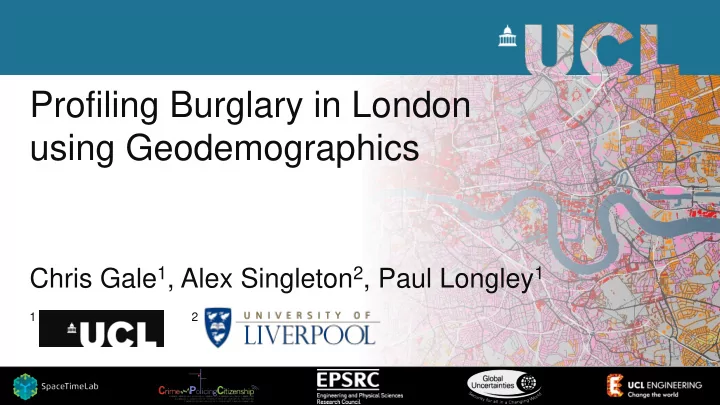

Profiling Burglary in London using Geodemographics Chris Gale 1 , Alex Singleton 2 , Paul Longley 1 1 2
Geodemographic Classifications • A Geodemographic Classification: – Simplifies a large and complex body of information about a population, where and how they live and work – Based on premise that similar people live in similar locations, undertake similar activities and have similar lifestyles and that such area types will be distributed in different locations across a geographical space • Clustering algorithms partition demographic data into groups sharing similar characteristics • Commercial (such as Mosaic created by Experian and Acorn created by CACI) and free (2011 OAC) classifications available
Geodemographic Classifications of London
2011 LOAC and coding crime data • Coding crime data to the 2011 LOAC • Police.UK data from December 2010 to July 2014 • Burglary the only crime category used
2011 LOAC and coding crime data • Assignment of different 2011 LOAC Supergroups to Output Areas in London
2011 LOAC and coding crime data • Road network overlaid on the 2011 LOAC Supergroups
2011 LOAC and coding crime data • Police.UK reported crime centroids added (for 4 million crime events)
2011 LOAC and coding crime data • 94,667 Voronoi polygons created based on reported crime centroids • Provides an estimation of the geography used to report crime on Police.UK
Assigning crime events to the 2011 LOAC • Two methods of attributing reported crime events to 2011 LOAC Supergroups tested: – Centroid location – Proportional assignment
Example of centroid location method 100 burglary events assigned to centroid = 100 burglary events assigned to ‘High Density and High Rise Flats’
Example of proportional assignment method 100 burglary events assigned to centroid = 80 burglary events assigned to ‘High Density and High Rise Flats’
Example of proportional assignment method 100 burglary events assigned to centroid = 20 burglary events assigned to ‘City Vibe’
Recorded Assigning crime Recorded crimes based 32 BOROUGHS OF crimes based on Difference on centroid LONDON events to the proportional locations assignment 2011 LOAC A: Intermediate Lifestyles 10.25% 10.26% 0.02% B: High Density and High • Only small differences 13.88% 13.56% -0.31% Rise Flats between the two methods C: Settled Asians 11.38% 11.09% -0.28% • However, if fewer crime D: Urban Elites 16.36% 16.51% 0.16% event records and/or a E: City Vibe 15.28% 15.48% 0.20% smaller geographic area of F: London Life-Cycle 8.69% 8.52% -0.18% study then greater G: Multi-Ethnic Suburbs 18.34% 19.10% 0.76% discrepancies between the two methods are likely H: Ageing City Fringe 5.84% 5.47% -0.36%
Index Scores of burglary rates by 2011 LOAC Supergroup • Score of 100 equates to London’s 2010 to 2014 average of 98 burglaries being committed per 1,000 dwellings
MPS Neighbourhood Classification • Built by the GLA • Based on the 2011 OAC methodology • Uses a different geography and 99 variables (from the 2011 Census and the London Datastore Ward Atlas)
Public Attitude Survey (PAS) • Used to elicit the public’s perceptions of policing needs, priorities and experiences with the Metropolitan Police Service (MPS) • 21 questions used to measure public confidence in the MPS • 33 to 34 interviews carried out per month per Borough
Neighbourhood Confidence & Crime Comparator • Interactive web-tool built visualising the 12 MPS Neighbourhood Classification clusters, Public Attitude Survey data and crime data • Overall confidence in the MPS across London
Neighbourhood Confidence & Crime Comparator • MPS Neighbourhoods assigned to the ‘Single - Living Centre’ cluster • Overall confidence in the MPS
Neighbourhood Confidence & Crime Comparator • MPS Neighbourhoods assigned to the ‘ Settled Multi-Ethnic ’ cluster • Overall confidence in the MPS
Neighbourhood Confidence & Crime Comparator • MPS Neighbourhoods assigned to the ‘ Crowded Outer Suburbia’ cluster • How well do the MPS communicate?
Neighbourhood Confidence & Crime Comparator • MPS Neighbourhoods assigned to the ‘ Stressed Urban’ cluster • How well do the MPS understand issues that affect the community?
Neighbourhood Confidence & Crime Comparator • MPS Neighbourhoods assigned to the ‘Single - Living centre’ cluster • Overall crime rate
Summary • Profiling Police.UK data with the 2011 LOAC is an example of using geodemographics to derive insight from open data sources • MPS Neighbourhood Classification and Neighbourhood Confidence & Crime Comparator are examples of creating bespoke geodemographic applications to contextualise public confidence in the police and crime levels in London
www.ons.gov.uk/ons/guide-method/geography/products/area-classifications/ns-area-classifications/ns-2011-area-classifications/index.html
www.opengeodemographics.com
geogale.github.io/2011OAC
oac.datashine.org.uk
plus.google.com/u/0/communities/111157299976084744069
Thank You This work was supported by EPSRC grants EP/J004197/1 (Crime, policing and citizenship (CPC) - space-time interactions of dynamic networks) and EP/J005266/1 (The uncertainty of identity: linking spatiotemporal information between virtual and real worlds) and ESRC grants ES/K004719/1 (Using secondary data to measure, monitor and visualise spatio-temporal uncertainties in geodemographics) and ES/L011840/1 (Retail Business Datasafe).
Recommend
More recommend